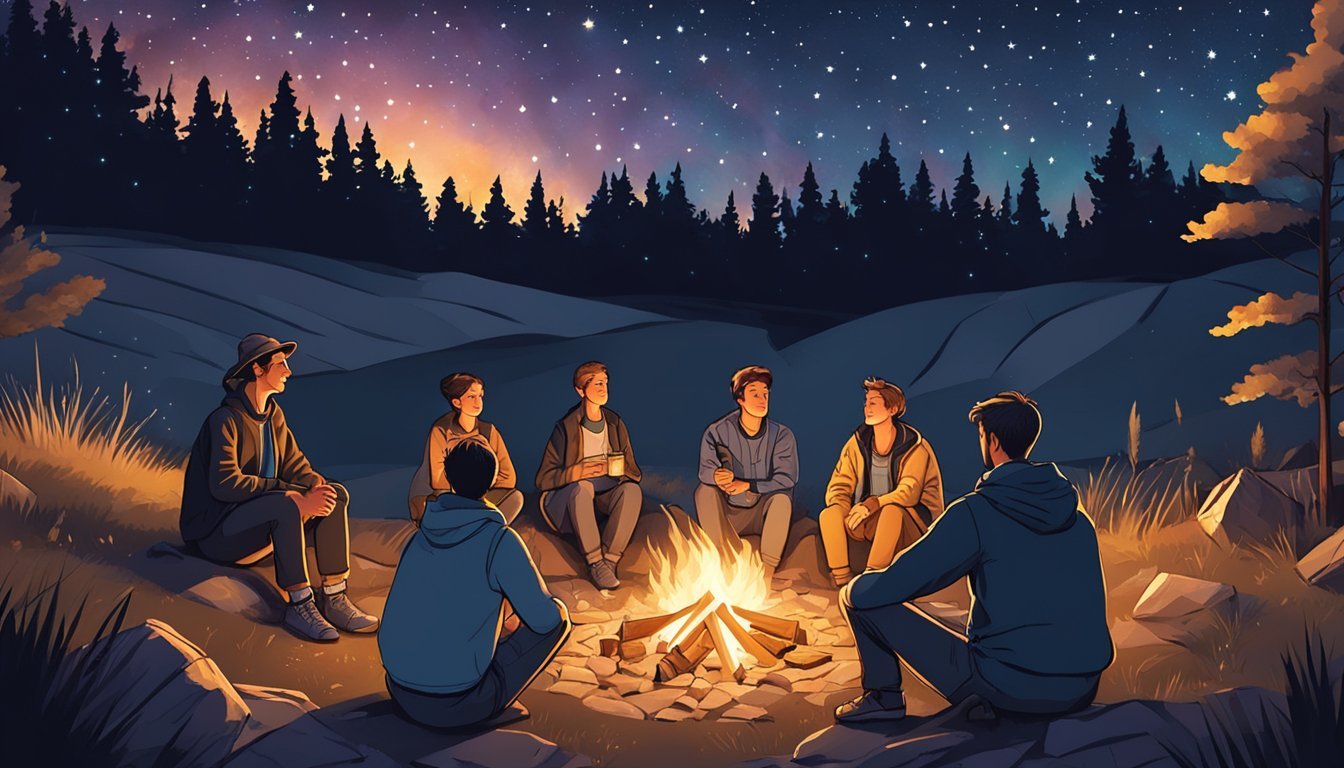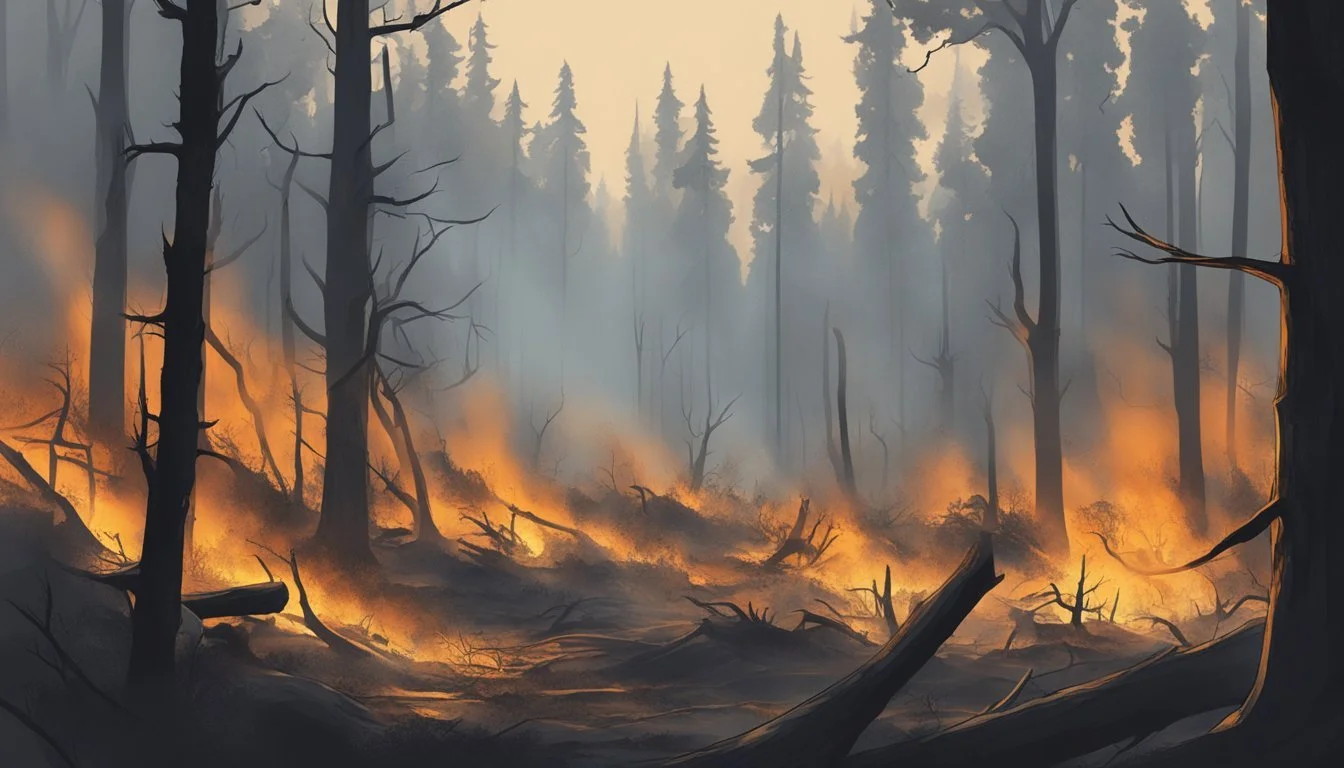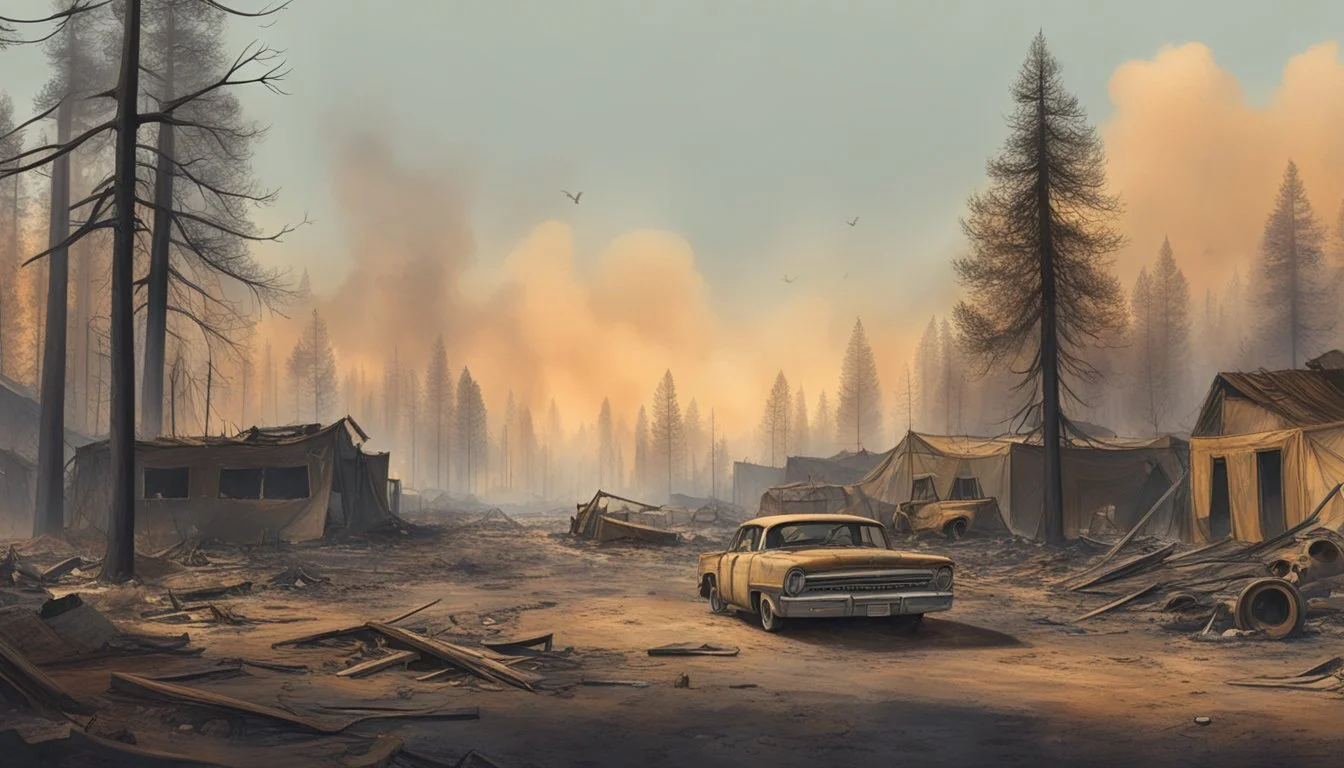Heartbreaking Documentaries Chronicle the 2018 Camp Fire Tragedy
Devastating California Wildfire Films
The Camp Fire of 2018 devastated Paradise, California, becoming the deadliest and most destructive wildfire in the state's history. Claiming at least 86 lives and destroying over 14,000 homes, this catastrophic event left an indelible mark on the community and the nation. Several documentaries have emerged to chronicle the harrowing experiences of survivors and first responders, offering intimate glimpses into the human impact of this tragedy.
These films capture the intense emotions and raw experiences of those who lived through the inferno. From the initial confusion and panic to the heartbreaking aftermath, each documentary provides a unique perspective on the disaster. Viewers witness the courage of residents fleeing the flames, the heroic efforts of firefighters, and the resilience of a community determined to rebuild.
The Camp Fire documentaries serve as powerful reminders of the devastating potential of wildfires and the importance of emergency preparedness. They also highlight the strength of the human spirit in the face of overwhelming loss. Through personal accounts and gripping footage, these films ensure that the stories of Paradise and its people will not be forgotten.
Contextualizing the Catastrophe
The Camp Fire of 2018 left an indelible mark on California's history and landscape. Its unprecedented scale and devastation reshaped communities and altered the region's environmental profile.
The Historical Significance of the Camp Fire
The Camp Fire stands as the deadliest and most destructive wildfire in California's recorded history. It claimed 85 lives and destroyed over 18,000 structures, primarily in Paradise, California.
The fire's rapid spread and intense heat overwhelmed emergency response systems. It exposed vulnerabilities in wildfire preparedness and urban planning in wildland-urban interface areas.
This disaster prompted significant policy changes in fire management and building codes across California. It also sparked national discussions on climate change's role in extreme weather events.
Geographical Impact on Northern California
The Camp Fire dramatically altered Northern California's landscape. It scorched 153,336 acres across Butte County, including Paradise, Concow, and surrounding areas.
The blaze's intensity left large swaths of land barren, increasing risks of erosion and mudslides. It disrupted local ecosystems and wildlife habitats, with long-term consequences for biodiversity.
The fire's smoke plume affected air quality as far as San Francisco and Sacramento. This widespread impact highlighted the interconnectedness of California's regions in the face of natural disasters.
Recovery efforts continue to reshape the affected areas, with ongoing debates about rebuilding in fire-prone zones.
Profiles of the Paradise
Paradise, a small town nestled in the Sierra Nevada foothills, faced unimaginable devastation during the 2018 Camp Fire. The community's resilience and the personal stories of those affected paint a poignant picture of loss and survival.
The Town of Paradise and Its Community
Paradise, California was a close-knit community of about 27,000 residents before the Camp Fire. Known for its natural beauty and small-town charm, it attracted retirees and families seeking a peaceful lifestyle. The town had a rich history dating back to the 1800s and was surrounded by pine forests.
Paradise's economy relied on healthcare, education, and small businesses. Feather River Hospital was a major employer. The town had several schools and a community college campus. Local shops and restaurants lined the main streets, creating a vibrant downtown area.
Nearby communities like Magalia and Concow were also heavily impacted by the fire. Many Paradise residents commuted to Chico for work or additional amenities.
Personal Stories of Residents and Evacuees
The Camp Fire forced a harrowing mass evacuation as flames engulfed Paradise. Residents describe terrifying escapes through smoke-filled streets, many unsure if loved ones had made it out safely. Some sought refuge in parking lots or nearby towns like Chico.
Survivors recount heart-wrenching losses - homes reduced to ash, cherished possessions gone, and in some cases, the deaths of family members or neighbors. The trauma of that day left deep scars on the community.
Many evacuees initially stayed with family or in shelters. Some relocated permanently, while others were determined to return and rebuild. The process of recovery has been slow and challenging for those who lost everything.
Stories of neighbors helping neighbors emerged amid the chaos, highlighting the community's strength. First responders and volunteers worked tirelessly to save lives and provide support in the fire's aftermath.
Chronicle of the Inferno
The Camp Fire's rapid spread and devastating impact were chronicled through firsthand accounts and official reports. This section examines the timeline of events, the critical role of first responders, and the efforts of firefighters and Cal Fire during the disaster.
Timeline of the Disaster
The Camp Fire ignited on November 8, 2018, at 6:33 AM near Pulga, California. Within hours, it had consumed thousands of acres and threatened the town of Paradise. By 8:00 AM, the fire reached Paradise, forcing residents to evacuate rapidly.
Strong winds and dry conditions fueled the fire's explosive growth. By noon, much of Paradise was engulfed in flames. The fire continued to spread over the next 17 days, eventually scorching 153,336 acres.
On November 25, 2018, the Camp Fire was fully contained. It left behind unprecedented destruction, claiming 85 lives and destroying 18,804 structures.
The Role of First Responders
First responders played a crucial role in saving lives during the Camp Fire. Dispatchers worked tirelessly, fielding hundreds of emergency calls and coordinating evacuation efforts.
Police officers and sheriff's deputies went door-to-door, urging residents to leave immediately. Many first responders risked their own lives to rescue those trapped by the fast-moving inferno.
Emergency medical personnel treated burn victims and those suffering from smoke inhalation. Their quick actions and dedication undoubtedly prevented further loss of life in the face of this catastrophic event.
Firefighters and Cal Fire's Response
Cal Fire led the firefighting efforts, with support from numerous local and out-of-state fire departments. Firefighters battled extreme conditions, including high winds and limited visibility due to smoke.
Cal Fire Captain Joe Amador described the scene as "apocalyptic," with embers raining down and spot fires erupting rapidly. Crews focused on evacuations and structure protection, often making split-second decisions in life-threatening situations.
Despite their heroic efforts, the fire's intensity and speed overwhelmed available resources. Cal Fire later emphasized the need for improved wildfire prevention and management strategies to better combat future blazes of this magnitude.
Behind the Camera
Documentary filmmakers captured the devastating Camp Fire through powerful imagery and personal stories. They faced significant challenges while documenting the tragedy, balancing sensitivity with the need to inform the public.
Documentary Filmmakers and Their Vision
National Geographic, Netflix, and Vice produced compelling documentaries about the Camp Fire. These filmmakers aimed to shed light on the disaster's impact and aftermath. Their vision focused on telling the stories of survivors, first responders, and the community's resilience.
Aye Moah and Nancy Hamilton of Golden Eagle Films created "Rebuilding Paradise," which chronicled the town's recovery efforts. The film followed residents over the course of a year as they struggled to rebuild their lives.
Netflix's "Fire in Paradise" took a more immediate approach, concentrating on the fire's rapid spread and evacuation. The filmmakers interviewed survivors and used cell phone footage to recreate the harrowing experience.
Challenges Faced While Documenting the Tragedy
Filmmakers encountered numerous obstacles while covering the Camp Fire. Access to affected areas was restricted, making it difficult to capture footage during and immediately after the disaster.
Emotional toll was significant. Documentarians had to balance their professional duties with empathy for traumatized survivors. Many grappled with how to portray the devastation without exploiting victims' pain.
Technical challenges included dealing with poor air quality and damaged infrastructure. Some crews used drones to capture aerial footage of the destruction safely.
Ethical considerations played a crucial role. Filmmakers had to decide how much graphic content to include and how to approach sensitive topics like loss of life and property.
Analyzing the Aftermath
The Camp Fire's aftermath brought profound changes to Paradise and surrounding communities. Residents faced immense challenges in rebuilding their lives and homes. Environmental impacts lingered long after the flames were extinguished.
The Long-Term Impact on Affected Communities
The Camp Fire's devastation extended far beyond the immediate destruction. Displaced residents struggled to find housing, with many forced to relocate permanently. Mental health issues spiked among survivors, with PTSD and depression becoming prevalent.
Local businesses suffered massive losses, leading to economic instability in the region. The fire also damaged critical infrastructure, including roads, power lines, and water systems. This made the return to normalcy a slow and difficult process.
Environmental concerns persisted, with toxic ash contaminating soil and water sources. Air quality remained poor for months after the fire, affecting residents' health.
Rebuilding and Restoration Efforts
Rebuilding Paradise and neighboring areas began almost immediately after the fire. Local authorities worked to clear debris and repair damaged infrastructure. Federal and state agencies provided financial assistance to support reconstruction.
Many homeowners faced challenges with insurance claims, delaying rebuilding efforts. Some residents chose to rebuild using fire-resistant materials and designs to mitigate future risks.
Community organizations played a crucial role in coordinating volunteers and resources. They helped distribute supplies, provided temporary housing, and offered emotional support to survivors.
Restoration of the natural environment became a priority. Efforts focused on replanting trees, stabilizing soil to prevent erosion, and protecting watersheds from contamination.
Lessons Learned and Future Preparations
The Camp Fire highlighted the need for improved wildfire preparedness and prevention strategies. Local governments revised evacuation plans and implemented better early warning systems.
Building codes were updated to require more fire-resistant materials in high-risk areas. Stricter regulations on power line maintenance were introduced to reduce ignition risks.
Firefighting agencies reassessed their tactics and equipment for combating fast-moving wildfires in populated areas. This led to investments in new technologies and training programs.
Public education campaigns were launched to raise awareness about wildfire risks and prevention. Communities began creating defensible spaces around homes and implementing regular brush clearance.
Climate change discussions intensified, recognizing its role in increasing wildfire frequency and severity. This spurred efforts to reduce carbon emissions and adapt to changing environmental conditions.
Exploring Causes and Accountability
The Camp Fire's devastation sparked intense scrutiny into its origins and culpability. Investigations revealed complex factors behind the catastrophe, while debates raged over who bore responsibility for the unprecedented destruction.
Investigations into the Causes
Pacific Gas and Electric Company's (PG&E) equipment failures emerged as the primary ignition source. A faulty electric transmission line near Pulga, California started the blaze on November 8, 2018. Investigators found the utility had not properly maintained the nearly 100-year-old power line.
Drought conditions and strong winds exacerbated the fire's spread. Climate change likely contributed to the extreme weather. Decades of fire suppression led to overgrown forests with high fuel loads.
Paradise's limited evacuation routes hampered escape efforts. The town's location in a fire-prone area increased its vulnerability.
Assigning Blame and Responsibility
PG&E faced intense criticism and legal consequences. The utility pled guilty to 84 counts of involuntary manslaughter. It agreed to pay $25.5 billion in damages to fire victims, insurers, and local governments.
Some argued climate change policies and forest management practices shared blame. Critics pointed to restrictions on logging and prescribed burns as factors in fuel accumulation.
Local officials faced questions about insufficient evacuation planning and emergency communications. Debates arose over allowing development in high-risk fire zones.
Ultimately, the Camp Fire's destructive power stemmed from a complex interplay of human decisions, aging infrastructure, and environmental conditions.
The Human Dimension
The Camp Fire documentaries explore the profound personal impacts of the disaster through firsthand accounts and emotional interviews. These films shed light on the trauma experienced by survivors and the lasting psychological effects of such a catastrophic event.
Interviews Capturing the Human Experience
Camp Fire documentaries feature powerful interviews with survivors, first responders, and community members. These personal stories provide intimate glimpses into the terror and chaos of evacuation, the heartbreak of loss, and the struggle to rebuild. Filmmakers capture raw emotions as interviewees recount harrowing escapes and describe watching their homes and livelihoods vanish in the flames.
Many documentaries include footage of residents returning to survey the damage, their shock and grief palpable on screen. These interviews humanize the disaster, allowing viewers to connect with individual experiences amidst the larger tragedy.
Emotional and Psychological Toll
The documentaries delve into the deep psychological wounds left by the Camp Fire. Survivors speak candidly about nightmares, anxiety, and PTSD in the aftermath. The films explore how the disaster shattered people's sense of safety and forever altered their relationship with nature.
Experts discuss the long-term mental health impacts on the community, particularly children. The documentaries highlight the importance of counseling and support services in the recovery process. They also examine survivor's guilt and the complex emotions of those who lost everything compared to those whose homes were spared.
Reflections on Wildfire Policy and Safety
The Camp Fire sparked crucial discussions on wildfire policies and safety measures. Policymakers and fire experts reassessed strategies to prevent future catastrophes and protect communities.
Examining Statewide Fire Policies
Cal Fire revised its approach to wildfire management after the Camp Fire. The agency increased funding for vegetation clearing and expanded its prescribed burn program. New building codes were implemented in high-risk areas, requiring fire-resistant materials and defensible space around structures.
Lawmakers passed legislation to improve emergency alert systems and evacuation procedures. Power companies faced stricter regulations on equipment maintenance and shutoffs during high-risk weather conditions.
Critics argued some policies didn't go far enough to address climate change's role in worsening wildfires. Debates continued over development in fire-prone areas and the balance between fire suppression and forest management.
Advancements in Wildfire Safety and Preparedness
The Camp Fire prompted significant improvements in wildfire preparedness. Communities developed more comprehensive evacuation plans, with clearly marked routes and staging areas. Many towns invested in emergency communication systems to provide timely alerts to residents.
Fire departments enhanced training programs and acquired new equipment for wildland firefighting. Drones and satellite technology improved fire detection and mapping capabilities.
Public education efforts intensified, teaching residents about creating defensible space and preparing emergency kits. Some insurers offered discounts for fire-resistant home improvements.
Scientists developed better fire behavior models to predict spread patterns. This data helped firefighters allocate resources more effectively during active blazes.
Impact on Popular Media and Culture
The Camp Fire tragedy left an indelible mark on popular media and culture. Its devastating effects inspired numerous creative works across various artistic mediums, serving to memorialize the event and raise awareness.
The Camp Fire in Film, Literature, and Art
Several documentaries emerged in the wake of the Camp Fire, offering powerful visual narratives of the disaster. Netflix's "Fire in Paradise" provided a sobering look at the catastrophe, featuring firsthand accounts from survivors and emergency responders. PBS also produced a documentary revisiting California's deadliest wildfire.
These films played a crucial role in bringing the Camp Fire's impact to a wider audience. They not only documented the event but also explored its long-term consequences on affected communities.
Beyond documentaries, the Camp Fire influenced other forms of media. Artists created poignant works depicting the fire's destruction and the resilience of survivors. Writers penned stories and poems reflecting on the tragedy, contributing to a growing body of literature focused on climate-related disasters.
The event's representation in popular culture helped keep public attention on wildfire risks and climate change issues long after the flames were extinguished.










